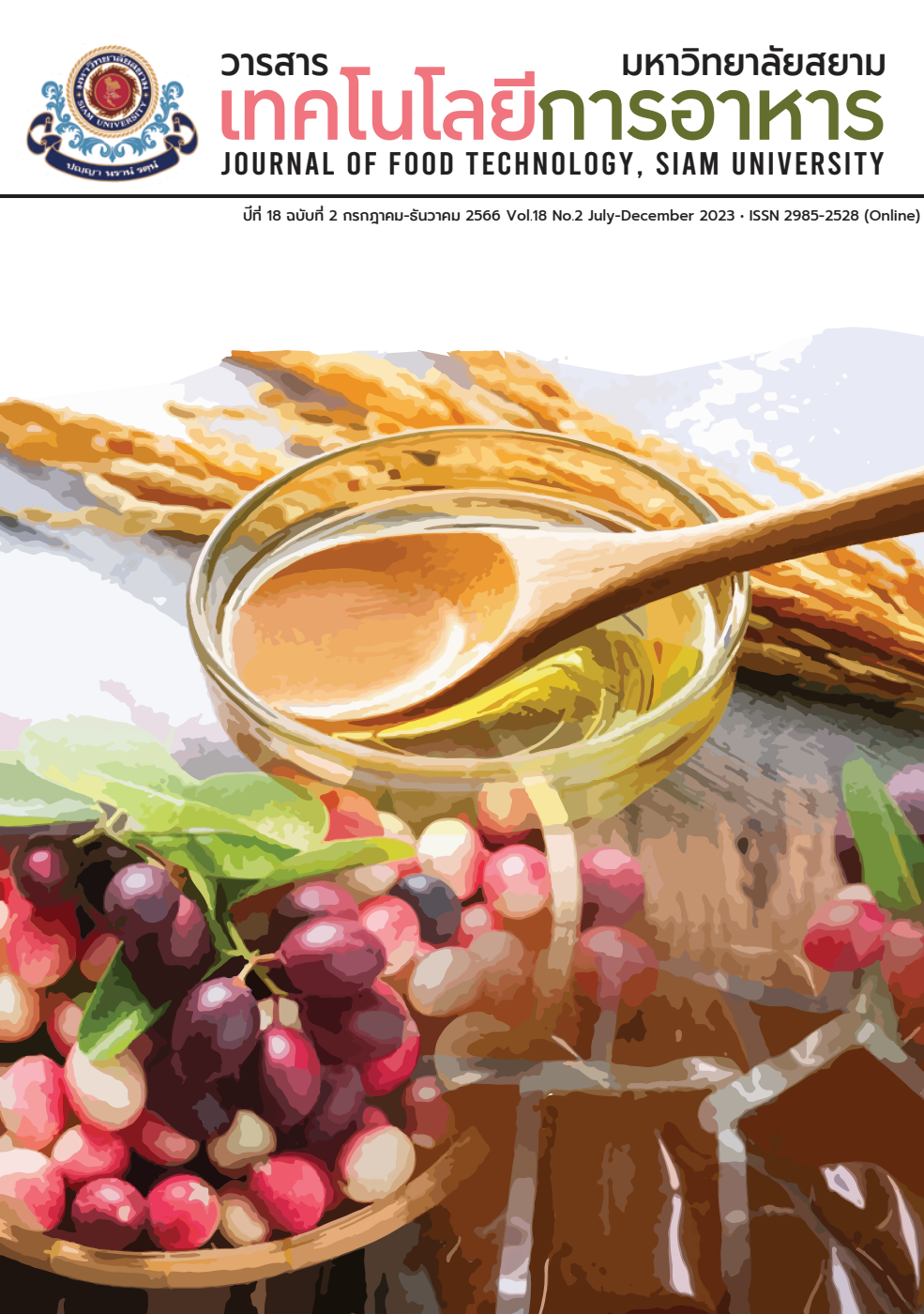Optimizing Extraction of Cellulose and Preparing Carboxymethyl Cellulose from Young Longan Fruit Waste
Main Article Content
Abstract
Young longan fruit is an agricultural waste from longan tree pruning. Young longan consists of cellulose, which could be synthesized into carboxymethylcellulose (CMC) for using as a food additive. The aims of this study were to optimize conditions for cellulose extraction from young longan fruit and to characterize the CMC prepared from the extracted cellulose. From the results, young longan fruit powder consisting of 13.5 % cellulose, 13.1 % hemicellulose and 11.7 % lignin (w/w). The conditions for cellulose extraction to produce high yield of crude cellulose (65.61 %) obtained from hydrolysis with the ratio of NaOH (6.0 %): longan powder with (80:20) extracting at 30 oC for 2 h. The crude cellulose was used to synthesize into CMC and confirmed CMC chemical structure by FTIR comparing with commercial CMC. The FTIR absorption band at 3415 cm-1 and 1628 cm-1 corresponded to hydroxy group (-OH) and carboxyl group (COOH) in polysaccharide, respectively. The viscosity of the prepared CMC was 1574 cP and the purity was 81.34 %, there was no statistically significant difference between the prepared CMC and commercial CMC. Thus, young longan waste could be produced to CMC to use in food products.
Article Details

This work is licensed under a Creative Commons Attribution-NonCommercial-NoDerivatives 4.0 International License.
Copyrights of all articles in the Journal of Food Technology available in print or online are owned by Siam University and protected by law.
References
Mussatto, S.I., Ballesteros, L.F., Martins, S. and Teixeira J.A. (2012). Use of agro-industrial wastes in solid-state fermentation processes. Industrial Waste. 274: 121–139.
Abraham, E., Deepa, B., Pothan, L.A., Jacob, M., Thomas. S., Cvelbar, U. and Anandjiwala, R. (2011). Extraction of nanocellulose fibrils from lignocellulosic fibres: A novel approach. Carbohydrate Polymers. 86(4): 1468–1475.
Wang, W., Liu, C., Huang, F., Li, W. and Zheng, C. (2019). Preparation and characterization of nanocellulose from rapeseed hull. Oil Crop Science. 4(1): 55–64.
Hutomo, G.S., Marseno, D.W. and Supriyanto S.A. (2012). Synthesis and characterization of sodium carboxymethylcellulose from pod husk of Cacao (Theobroma cacao L.). African Journal of Food Science. 6:180-185.
Yue, Y., Han, J., Han, G., Aita, G.M. and Wu, Q. (2015). Cellulose fibers isolated from energy cane bagasse using alkaline and sodium chlorite treatments: Structural, chemical and thermal properties. Industrial Crops and Products. 76: 355-363.
Jia, F., Liu, H. and Zhang, G. (2016). Preparation of carboxymethyl cellulose from corncob. Procedia Environmental Sciences. 31: 98-102.
Rehman, N., Alam, S., Amin, N.U., Mian, I. and Ullah, H. (2018). Ecofriendly isolation of cellulose from Eucalyptus lenceolata: a novel approach. International Journal of Polymer Science. 1: 1-7.
Ye, H., Xu, S., Wu, S. and Chen, W. (2018). Optimization of sodium carboxymethyl cellulose preparation from bagasse by response surface methodology. IOP Conference Series: Materials Science and Engineering. 1: 1-6.
Heinze, T. and Pfeiffer, K. (1999). Studies on the synthesis and characterization of carboxymethylcellulose. Applied Macromolecular Chemistry and Physics. 266: 37–45.
Mondal, M.I., Yeasmin, M.S. and Rahman, M.S. (2015). Preparation of food grade carboxymethyl cellulose from corn husk agro waste. International Journal of Biological Macromolecules. 79: 144-150.
Candido, R.G. and Goncalves, A.R. (2016). Synthesis of cellulose acetate and carboxymethyl cellulose from sugarcane straw. Journal Carbohydrate Polymers. 152: 679-686.
Goering, H.K. and Van Soest, P.J. (1970). Forage fiber analysis (Apparatus, reagents, procedures, and some applications). In Agricultural Handbook No. 379, pp. 1-20. US Government Printing Office, Washington, DC.
Inari, G.N., Mounguengui, S., Dumarcay, S., Pétrissans, M. and Gérardin P. (2007). Evidence of char formation during wood heat treatment by mild pyrolysis. Polymer Degradation Stability. 92: 997–1002.
American Society for Testing and Materials. (2004). Method ASTM: D1439-03.
Jiang, M., Zhao, M.M., Zhou, Z.W., Huang, T., Chen, X.L. and Wang Y. (2011). Isolation of cellulose with ionic liquid from steam exploded rice straw. Industrial Crops and Products. 33 (3): 734-738.
Rahaman, M.S., Nahar, S.S., Islam, J.M.M., Samadder, R., Rahaman, M.S., Chadni, R.K., Shagor, F.R., Rahman, M.L., Ruhane, T.A., and Khan, M.A. (2022). Utilization of waste textile cotton by synthesizing sodium carboxymethyl cellulose: an approach to minimize textile solid waste. Advances in Polymer Technology. doi:10.1155/2022/4255409
Orue, A., Jauregi, A., Unsuain, U., Labidi, J., Eceiza A. and Arbelaiz, A. (2016). The effect of alkaline and silane treatments on mechanical properties and breakage of sisal fibers and poly (lactic acid)/sisal fiber composites. Composites Part A: Applied Science and Manufacturing. 84: 186–195.
Razali, N.A.M., Sohaimi, R. M., Othman, R.N.I.R., Abdullah, N., Demon, S. Z.N., Jasmani, L., Yunus, W.M.Z.W., Ya’acob, W.M.H.W, Salleh, E.M., Norizan, M.N. and Halim, N.A. (2022). Comparative study on extraction of cellulose fiber from rice straw waste from chemo-mechanical and pulping method. Polymers. 14(3): 387.
Abdul Karim, M.S., Zainol, N., Abu Hassan As’ari, N.I.A., Abu Talip Yusof, N. and Aziz, N.H. (2022). Effect of processing parameters on cellulose content extracted from pineapple leaf. Biocatalysis and Agricultural Biotechnology. 42:102339.
Wang, X., Li, H., Cao, Y. and Tang, Q. (2011). Cellulose extraction from wood chip in an ionic liquid 1-allyl-3-methylimidazolium chloride (AmimCl). Bioresource Technology. 102 (17): 7959-7965.
Hospodarova, V., Singovszka, E. and Stevulova, N. (2018). Characterization of cellulosic fibers by FTIR spectroscopy for their further implementation to building materials. American Journal of Analytical Chemistry. 9(6): 303-310.
Hidayat, S., Ardiaksa, P., Riveli, N. and Rahayu, I. (2018). Synthesis and characterization of carboxymethyl cellulose (CMC) from salak-fruit seeds as anode binder for lithium-ion battery. Journal of Physics: Conference Series.1080. 012017.
Pushpamalar, V., Langford, S.J., Ahmad, M. and Lim, Y.Y. (2006). Optimization of reaction conditions for preparing carboxymethyl cellulose from sago waste. Carbohydrate Polymers. 64(2): 312-318.
Rachtanapun, P., Luangkamin, S., Tanprasert, K. and Suriyatem, R. (2012). Carboxymethyl cellulose film from durian rind. LWT-Food Science and Technology. 48(1): 52-58.
Haleem, N., Arshad, M., Shahid, M. and Tahir, M.A. (2014). Synthesis of carboxymethyl cellulose from waste of cotton ginning industry. Carbohydrate Polymers. 113: 249-255.


